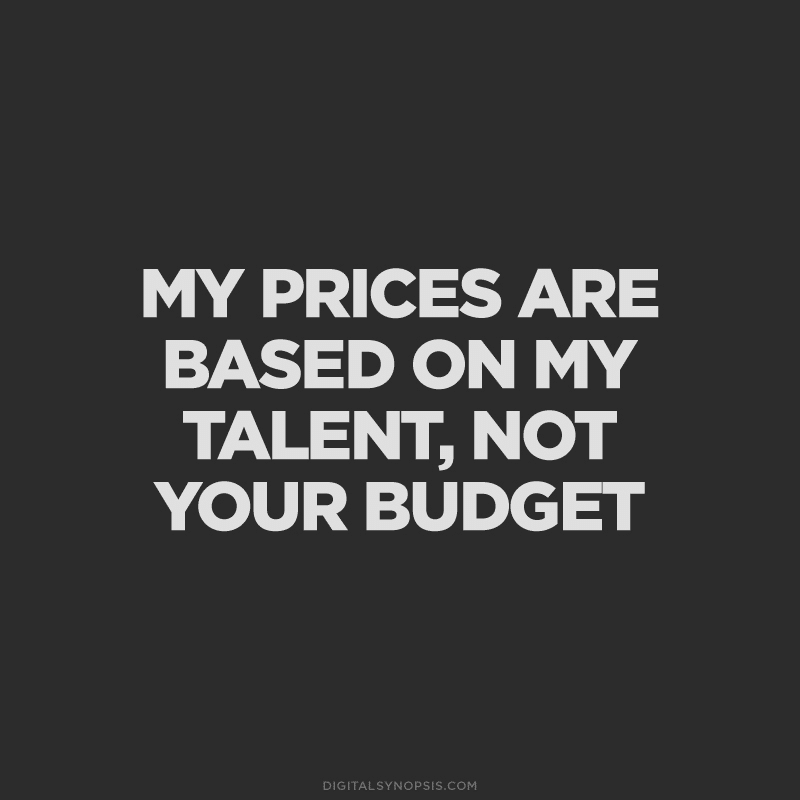Charging Your Worth – How To Do It And Why You Must

There has been a lot made of people charging their worth over the last year or so.
Mercifully it seems that the industry is finally waking up to the fact that if we don’t correctly charge for our treatments and services then we really don’t have a business at all — we’ve a hobby at best…
Potentially a hobby that costs us a lot of money and headaches, too.
[Which is a bit rubbish as hobbies are supposed to be fun, aren’t they?]
In this blog we’re going to look at;
- what it means to charge your worth
- why it’s more important than ever to get your pricing correct
- how to properly work out your prices (and how not to do it)
- how to get more help if you need it
Sound good?
Great, let’s begin.
Now I understand entirely that not everyone likes to talk about money.
To begin with it’s not very British, is it?
It’s seen as a big vulgar and uncouth to discuss one’s wealth but you’re going to have to get over that for the next few minutes as you read on.
Whilst I don’t believe that money is the be-all-and-end-all of everything; I promise you that your life will be easier with some it.
“Money isn’t everything …but it ranks up there with oxygen.” – Zig Ziglar
Let’s begin by looking at why as an industry we’re so bad at charging our worth.
Is it a lack of self belief, self worth or self esteem?
Is it because we simply don’t understand what all the numbers mean?
Is it a lack of confidence in actually asking for the money in exchange for our services?
As my friend JP De Villiers says, “If you don’t charge your worth… then you’re worthLESS.”
Whatever the reason I’m going to encourage you to put a stop to it right now.
It’s time to stand up for your trade, your skill set and your value to the marketplace and start commanding more money…
I mean, at least enough so that you actually make a profit and stop working for free.
That would be a good place to start.
So, where does charging your worth start… and what does it even mean?
Well, for me, changing your worth is all about the value that you bring to the marketplace.
In fact according to Jim Rohn — one of the greatest speakers and personal development experts of all time — you are paid equal to the value that you bring to the marketplace.
That means that the more valuable you are to the marketplace — the more money you’ll earn.
Something worth knowing, right?
Also a great reason to ensure that you’re valuable.
That could mean because you’re excellent at what you do, you deliver it in a unique way or maybe you have certain skills or qualifications that others don’t.
Remember that when you’re setting your prices (perhaps your new, higher, ones) you’re charging for so much more than just your time.
We’ll get into the tangible elements you need to charge for later (such as a portion of your rent, for example) but there are also all of the intangibles too.
For example, part of what makes up your prices should reflect;
- your level of expertise
- your training
- your experience
- your qualifications
I mean, how long would it take someone to get to your level starting from scratch?
You’ve a skillset, experience and you’re great at what you do — it’s imperative that you charge for that and not only for your time and the products used!
Ultimately, if you don’t value yourself then nobody else is going to either.
The buck stops with you.
But here’s the other thing…
You’re more than just the service you deliver.
You’re a life saver.
A problem solver.
A pain killer.
You’re all of these things and so many more… in the eyes of the appreciative client.
When someone else understands — and appreciates — the value you’re bringing then they are going to be delighted to pay the fee commanded.
And if your existing clients don’t appreciate it… well maybe it’s time to find yourself some new ones. I promise you that there are plenty more out there.
This is why it really pays to deal in transformations, breakthroughs and real results — people will pay a lot more for those.
So I believe that your pricing is made up of two beliefs; what you believe your value is… and what the marketplace believes your value is.
Your positioning and branding in the marketplace make up an important factor also.
How else would you explain the fact that Tiffany sold a $150,000 advent calendar last year?
Or that they sell a paperclip for $1,500.
Yes, a paperclip.
So market positioning is key too; another reason why you must position yourself as the expert and don’t be shy about shouting to the world how good you are and how you can help transform the lives of others with your superpowers.
If you’re viewing yourself as “just a nail technician”, for example, then that’s how the world is going to view you too.
And they’ll pay you accordingly.
Remember, it starts with you.
Of course in the current climate it has never been more important to price yourself correctly.
With rising bills across the board if you’ve not done your numbers right then you could well be working at a loss… and that’s not fun for anyone.
Rising utility bills, rising product costs and who knows what else over the next twelve months as the world recovers from the pandemic.
Inflation in the UK is currently at its highest rate for a decade… and is pushing 5%.
That means that if you don’t adjust your prices in the same way then you’ll effectively be topping up the prices for each and every client you serve by the same amount.
Just think about that for a moment.
Now before we look more closely at some guidance in setting your prices the correct way, let’s first address how not to do it.
Sadly, I see a lot of that.
So many people take the route of “see what another salon is charging and reduce it a little”.
I understand the logic behind that sentiment, but it’s deeply flawed.
You see you don’t know anything about those other businesses.
You don’t even know if they make a profit — perhaps they just made up their prices, too.
It could be like the blind leading the blind in that case!
You also know nothing else about that business; what their costs are, how much rent they pay, if they own the premises, if they have a team to pay, whether they are VAT registered or even what the goals and dreams of the owners are.
Making up prices, guessing or averaging the prices of others really isn’t the place to start.
There’s another problem with it too.
If you’re not careful you’ll end up positioning yourself in the most competitive part of the marketplace… and that’s just above the bottom.
It’s a horrid place to be.
You see lots of other businesses have set their prices in the same way as described above.
They too probably don’t really know how much money they are making or the relationship between their costs and their prices.
As a result they are all competing with one another.
Even discounting to try and remain even more “competitive”.
It’s a flat-out race to the bottom.
Owners slash quality and use cheaper and cheaper products to keep the prices low, diminishing their profits even more.
As a result the quality of the treatments and services suffer and the industry gets a bad name.
I promise you, nobody wins.
It’s actually a much smarter strategy to aim yourself at the top end of the market.
There’s less competition, for one.
Plus there are no end of people who will pay for luxury, quality and a thoughtful experience.
They tend to be better clients, too.
They’ll take your upsells. They’ll bring their friends. They’ll have the extra half an hour.
They won’t haggle or expect a discount.
These people exist; but you’ll never attract them by trying to be the cheapest. That’s the opposite of what they are looking for.
So just how do you calculate your prices?
[Note the use of the word ‘calculate’ rather than ‘choose’]
It needs to be done on a mathematical basis, and not an emotional one.
Remove the emotion and don’t worry about what others are doing.
Ultimately, if you’re not pricing to make a profit then you really do have a hobby rather than a business.
That may sound harsh but it’s the reality.
Our industry work too damned hard to not actually have something left over when all the bills are paid.
That’s also what it comes down to.
Your profit is the bit you’re left over with after you’ve paid out all of your costs — including your taxes — the goal is to make sure there is enough for you to have the life you want.
Let’s pause right now to consider some of those other costs.
Of course, some are obvious, but there are a few little hidden ones we forget about too — and they all need to be accounted for.
You’ll need to consider;
- all of your different insurances (and there are many)
- premises costs
- staffing and employment (including your own wage)
- stock
- costs of sales and marketing
- taxes
- finance costs
- broadband
- utility bills
- furniture
- stationary and printing
- software licences
- data storage
- cleaning
- accountancy and other professional fees
- payment processing fees
And the list goes on… and on… and on.
The key is making sure that you’re billing all of these to your clients.
Remember that if you don’t then you’ll be picking up the tab.
Ouch.
So here’s what you need to do.
Firstly, you need to know what it costs to run your business. You need to go through a bank statement or your accounts for last year and actually add up all of those costs on an annual basis.
At this stage, we want all of the indirect costs for a whole calendar year.
That means costs that occur whether you deliver a treatment or not (like your phone bill, rather than massage oils, for example).
All of these costs need to be accounted for and the simplest way to do that is have each and every treatment you deliver pay a tiny portion of each of those costs.
That way nothing will be missed.
Next, work out how many minutes per year you’re open for. You’ll want to consider each of your staff columns (if appropriate and also allowing for part timers) as well as time you might enjoy off for bank holidays and holiday time.
Now at the moment this figure assumes 100% occupancy all of the time, which probably isn’t realistic. Adjust the number to reflect what is accurate for your business. (For example for 75% occupancy you’d multiply the number of minutes you’re open for by 0.75).
This will give you an adjusted figure for the number of active minutes you’re delivering treatments for in a year… or thereabouts.
When you divide the total indirect cost figure by the number of active minutes then you’ll have the indirect costs per minute number.
Every column minute you’re booked is now contributing this amount toward your indirect costs.
For each and every treatment you offer you’ll now need to calculate the direct costs for each one.
This takes into consideration costs which are only applied when the treatment takes place, such as consumables.
You now have the numbers so you can calculate your current treatment profitability.
Price charged to the client (less VAT, that’s not yours it belongs to HMRC)
Less: Cost of products and consumables (direct costs)
Less: Share of indirect costs (per minute, based on treatment time)
Equals: pre-tax profits per minute, for that treatment
If you do this exercise for your own menu then you might be surprised at some of the numbers.
[There’s a free download with no opt-in here to help]
Heck, you might even be horrified!
There are so many business owners blissfully unaware of which treatments actually make them a good profit and which don’t…
And if you don’t know which your most profitable treatments are; how do you know which ones to promote!
So many salon owners are actively promoting the treatments which make them the least profit — without even knowing it.
Don’t make that mistake.
Even if your business only delivered ten treatments per day then adding an extra £5 profit per treatment would add up to around £15,000 per year.
That’s a lot of extra money for you to take home or reinvest into the business.
Don’t leave it to guesswork.
This could be the most important exercise you’ve ever done.
For help with working out your own pricing — and to ensure your prices include the profits that you dream of — we have built a special online tool which is available to members of our Salonology Gold Club at both Light and Plus levels.
Find out more here.
To get your hands on Ryan’s best selling book for salon owners – and just cover the postage – click here.
Photo by Josh Appel on Unsplash


